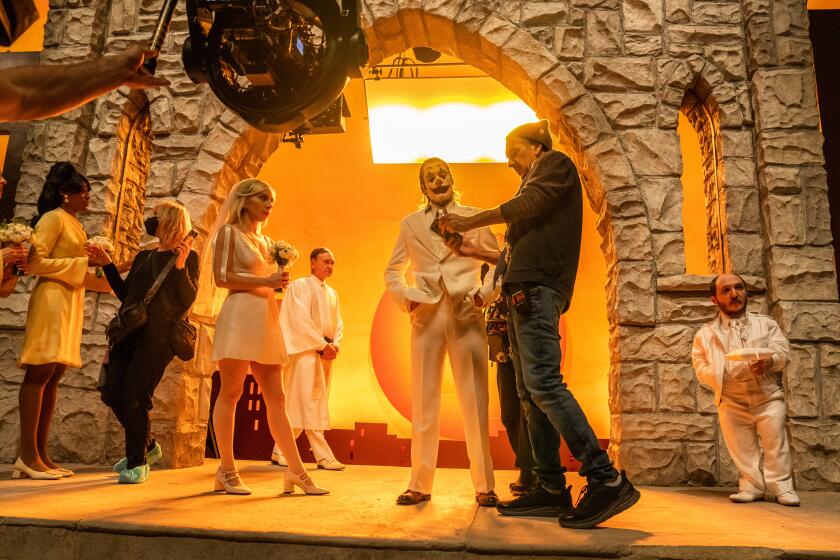All the signs of a David Fincher flick
DAVID FINCHER, the director of “Se7en” and “Fight Club,” has a reputation for obsessiveness. It’s a quality apparent in the perfectionist virtuosity of his visual style and backed up by the stories of countless takes and other taskmaster demands that tend to emerge from his marathon shoots. Only his sixth feature in 15 years and his first since “Panic Room” in 2002, “Zodiac,” out on DVD this week, makes literal the underlying theme of Fincher’s career. It’s a paean to obsession, a dream match of subject and filmmaker.
Cracking open one of the best-known cold cases in recent history, the movie retells the story -- already the inspiration for several films, most famously “Dirty Harry” (1971) -- of a serial killer who terrorized the Bay Area in the late ‘60s and early ‘70s. The Zodiac, as the murderer called himself, sent taunting letters and cryptograms to local newspapers. He was never caught or identified, and Fincher seizes on this absence of closure as the knotty substance of his film. (There are parallels with William Friedkin’s 1980 thriller “Cruising,” due out on DVD this fall, and “Memories of Murder,” a 2003 drama by the Korean director Bong Joon-ho. Both are also serial-killer movies without solutions, focused more on the pursuers than the pursued.)
Fincher and screenwriter James Vanderbilt, adapting two books on the Zodiac killer by Robert Graysmith, essentially conducted their own investigation -- double-checking reports, disqualifying hearsay and even turning up evidence that had eluded the police. In sticking to the facts, “Zodiac” is notably indifferent to the requirements of the typical crime movie. The canvas is bigger, the time span longer, the plot more detailed, the overall shape more diffuse and the resolution altogether less reassuring. “Zodiac” does not subvert so much as methodically exhaust the genre, and therein lies its unexpected genius.
Fincher dispenses with the murders swiftly: one at night on a lovers’ lane, another in broad daylight by a lake in Napa. Much of the film unfolds in police precincts and newsrooms, in the company of cops and reporters entangled in the investigation. The three most tenacious hunters -- eager-beaver newspaper cartoonist Graysmith (Jake Gyllenhaal), dandyish crime reporter Paul Avery (Robert Downey Jr.), prickly homicide detective David Toschi (Mark Ruffalo) -- do not exactly work in tandem.
They may have a common goal, but the film emphasizes the solitary (and indeed alienating) nature of their fanatical quests. Where in most serial-killer movies -- and certainly in Fincher’s hugely influential “Se7en” (1995) -- the urgency arises from a desire to prevent the murderer from striking again, here it has more to do with the protagonists’ desperate need to make sense of things and by extension maintain a grasp on sanity.
The lack of conclusive answers eats away at the heroes, but it gives the film a perverse clarity. Blind alleys and red herrings are whodunit staples; in “Zodiac,” though, they arise organically and in abundance. The viewer experiences these detours and false starts not as bait-and-switch narrative devices but as valid methods of processing information in a world of imperfect knowledge. And there’s a ton of information to process. In this brisk, dense, 2 1/2 -hour movie, hardly a minute goes by without a new piece to fit (or not, as the case may be) in the puzzle.
All three leads are superb, Ruffalo in particular, but there’s also exemplary work on the margins from John Carroll Lynch (as a prime suspect), Philip Baker Hall, Brian Cox, Elias Koteas, Donal Logue and especially Anthony Edwards (as Toschi’s partner).
Bookended by Donovan’s hippie anthem “Hurdy Gurdy Man” (indelibly desecrated by its chilling use here), “Zodiac” is a period piece that commemorates the passing of a period. The Zodiac killings, along with the Altamont stabbing and Manson family murders, rudely cut short what had started during the summer of love. The culture moved on. This particular serial killer faded from view. But “Zodiac” sticks around for the grim hangover, as the thrill of the chase cedes to the fatigue of failure (and the occasional flash of hindsight). Perhaps even more than obsession, the film’s real subject and secret weapon is that most underrated of virtues: patience.










